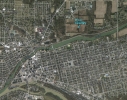1750
Colonial Period Pioneers
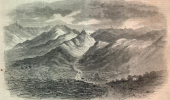
1. Alexander Wilson b. circa 1750, d. April 1786, ; m. circa 1770 to Nancy Naylor.
1.1.1 Elizabeth Knox Danford, b. Sept. 30, 1790; m. Samuel Lane
1.2 Elizabeth Wilson, b. circa 1772 ; m. June, 25, 1796 John McBain in Jefferson Co., Kentucky.
1.2.1 Mary Polly McBain, b. Jan. 20, 1799 (Louisville, KY)
1.4 Samuel Naylor Wilson, b. Mar. 7, 1784, ; m. Aug. 1811 Sarah Baker, b. 1779 in PA, (daughter of Isaac Baker.
During the American Revolution (1775-1783) the Wilson family continued westward along the Wilderness trail thru Kentucky to the Ohio and Wabash river, and were in Post St. Vincent, Vincennes (Knox County) Indiana March of 1786.3
After the Revolution, several dozen Kentucky families settled in Vincennes. Friction between these Americans, the French local government and the native peoples moved Virginia Governor Patrick Henry to dispatch George Rogers Clark and send troops to the region. Clark arrived at Vincennes in 1786. His attempts to negotiate with neighboring native peoples were unsuccessful. Instead, he created an incident by seizing the goods of Spanish traders, enraging the local population and risking war with Spain. Under orders from the new United States government, Clark and his men left Vincennes in the spring of 1787. 11

Wilderness Trail maps
The Wilderness Road was the principal route used by settlers for more than fifty years to reach Kentucky from the East. 2 In 1775, Daniel Boone blazed a trail for the Transylvania Company from Fort Chiswell in Virginia through the Cumberland Gap into central Kentucky. It was later lengthened, following Native American trails.
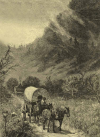
The ‘Logan Trace’ section of the trail extended to Harrodsburg, KY, and later trails continue on to the Falls of the Ohio River at Louisville, KY
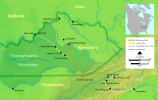

George Rogers Clark (older brother to William Clark of the Lewis and Clark expedition) was a soldier from Virginia and the highest ranking American military officer on the northwestern frontier during the American Revolutionary War. He served as leader of the Kentucky (then part of Virginia) militia throughout much of the war.
From his headquarters at Fort Harrod, KY, Clark had been keeping a diary that reveals the desperation of the settlements:
(We do not know if Hugh Wilson is a relative of Alexander.) 1
On June 1, 1786 "Widow Willson" joined with other "Americans at Vincennes" to petition the U.S.. Congress for stronger defense -too late for the widow and her small children.” 4
Alexander Wilson died at age 36, leave a wife and four young children. Settlement of the estate of Alexander Wilson included a land grant for his valiant service in the Vincennes militia. The children of Alexander and Nancy Wilson are listed; Mary, Elizabeth, Walter, and Samuel Nailor (sic). 1
Exactly how Nancy and the children survived is unknown. Mary and Elizabeth were 15 and 14 years old, but Walter was only 4, and Samuel 2 years old. Not old enough to hunt or fish yet. She may have had her relatives there to help her. There are several families shown on early census with the Wilson and Naylor (if that is her maiden name) close by. 1
Nancy Wilson, 3rd marriage May 11, 1814 John Couret White, d. Apr. 28, 1835 Sullivan Co., IN.
Vincennes, the oldest city in Indiana, was named after François Marie Bissot, Sieur de Vincennes, and began as a French fur trading outpost founded in 1732. In 1786 the area was part of the Indian Reserve in the Northwest Territory, assigned to the United States in the Treaty of Paris 1783.
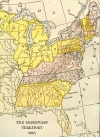
Northwest Territory - 1787
During the American Revolution, conflicts intensified in Kentucky. Armed and encouraged by the British, Native Americans waged war and raided the Kentucky settlers in hopes of reclaiming the region as their hunting ground. The Continental Army could spare no men for an invasion of the Northwest or the defense of distant Kentucky, so its defense was left entirely to the local population. 8
1782

Battle of Tippecanoe
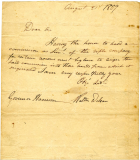 Lt. Walter Wilson's letter to Gov. Harrison, 1807 |
Wilson Family Cemetery - Aerial view of Logansport, Indiana. 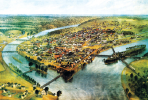 Logansport Indiana |
1.3.2 Thomas Wilson, b. circa 1807 ; 1824 living in Princeton, Knox Co., In. ; 1829 living in Clay twp. ; 1837 made a judge per (L.T.) newspaper. Lived North of Eel river, South of Chase Rd., East of the Michigan Rd. on W1/2 S19, Clay Tp. gate to the home was at the bridge across Horney Run (Creek) ; 1866 adms of Patrick Lynch dec'd.; per (L.J.0 1859, Cass Co. Temperance Society; per (D.P.) newspaper or (L.J.) on the Union Congressional Central Committee; per L.J. newspaper.April 1838 candidate for town board; April 1837 treasurer of the Eel River & Michigan Rd. Free Bridge; had the subscription books of the company at his store; commissioner of the road company; 6-29-1838, a speaker in the Logansport Lyceum series; per L.T newspaper.
1.3.3 Col. John M. Wilson, b. circa 1809; m. Myra () Soldier in the war with Mexico, raised a company of volunteers and served during the war as captain. He entered the army of the Union in the war of the Rebellion as captain in the Thirteenth regiment of the Indiana Volunteer Infantry, was promoted to the position of major and lieutenant-colonel of that regiment, and was mustered out August 5, 1864. He re-entered the service as colonel of the One Hundred and Fifty-fifth Regiment and served as such to the close of the war. By profession he was a lawyer and after the war he resumed practice, in Peru.
1.3.3.2 Sarah Wilson
1.3.4 Mary Ann Wilson, b. ; m. ca 1824 to George Smith. Resided S&E of Broadway. Levi Smith was her adms per Logansport Journal.
1.3.4.1 Indiana Smith, b. ; m. Judge Daniel Pratt Baldwin
1.3.5 William R. Wilson, b. Jan. 28 1818 ; m. (1) Martha A. Campbell b. circa 1830. Had a stage line with Saml. L. McElheny, had a livery stable, facing the Wabash Valley and Lake Erie Canal 5th St. the first 20 feet S. of Broadway Lot 59 OP; Trustee of First Universalist Church; postmaster before 1865, appointed for 4 more years, did pork packing in the express office at 417 E. Market St. ; Per newspaper Sunday Nov. 27, 1983 article: William, youngest child of
Walter and Mary Wilson became postmaster of Logansport, and also served as
city marshal and city councilman.
From Walter Wilson's biography:
The Governor, General William Henry Harrison, would become the 9th President of the United States, taking office in 1841.
The roll of Companies of Indiana Militia, show Captain Walter Wilson, commanding from September 18 to November 18, 1811, and serving in the Battle of Tippecanoe, Indiana, November 7, 1811. 6
In the account of the battle of Tippecanoe taken from the official dispatch sent by General Harrison to the secretary of war, on the 18th of November, eleven days after the battle:
"… Several of the militia companies were in no wise inferior to the regulars. Spencer's, Guiger's and Warrick's maintained their posts amid a monstrous carnage
-- as, indeed, did Robb's, after it was posted on the right flank. Its loss of men (seventeen killed and wounded), and keeping its ground, is sufficient evidence of its firmness. Wilson's and Scott's companies charged with the regular troops, and proved themselves worthy of doing so.” 7
From his biography:
“… In that bloody attack upon the Mississinawan town, Colonel Wilson commanded the left flank of the advancing columns, in the battle which occurred in July 1813. He continued in active service during the succeeding campaigns against the Indians, until the cecession of hostilities, acquitting himself with the highest credit as an officer and soldier. In recognition of his ability he was elected a member of the Legislative Council of the Territory from Knox County, in 1810, and continued a member during several sessions. He was also a member of the first session of the Legislature, after the organization of the state government in 1816. About 1821 he became a resident of Gibson County, and of Eel River, within the present limits of Logansport. In 1831-32 he represented his district Carroll and Cass Counties in the State Legislature.” 6
“… After a short illness he died March 18, 1838 and was buried by the members of the Tipton Lodge, with the usual Masonic honors." His Tombstone says he was "honest, brave and patriotic." Buried at Wilson Family Cemetery, Logansport, IN” 6
*Captain Walter Wilson, *Lieutenant Benjamin Beckes, Ensign Joseph Nacomb, Sergeant Thomas J. Withers, Sergeant John Decker, *Sergeant Thomas White, Sergeant Isaac Minor, Corporal Daniel Risley, Corporal William Shuck, Corporal John Gray, Corporal Peter Brenton.
PRIVATES
William Gamble, Batost Chavalar, Joseph Harbour, James Jardon, John
Anthis, *Louis Reel, died Oct.13.1811, Richard Greentree, Jacob Antis. *Nathan
Baker, Sinelkey Almy, Moses Decker, Woolsey Pride, *Abraham Pea, William
Pride, Jacob Harboson, Joab Chappell, John Risley, Isaac Walker, James Purcell, William Brenton, Thomas Chamers, Adam Harness, John Chambers, Louis Frederick, Asa Thorne, Samuel Clutter, James Walker, John Bargor, Peter Bargor, Joseph Woodry, Robert Benton, Thomas Milbourne, Benjamin Walker, Sutten Coleman, Robert McClure, John Waker, David Knight.
American State Papers, U.S. Congress, Series 8, Public Lands. Volume 7, page 723 -Locations entered at Vincennes, under the act of Congress of February 13, 1813, from 12th July to 30th September, 1813.
Wilson Family Burial Ground - Logansport, IN.
"On the
Wilson farm north of Eel River, just outside the city, in the center of a field
opposite the north end of Seventeenth street are buried Gen. George Wilson,
March 18. 1838, age fifty-six; Gen. George Wilson's wife, January 6, 1865; Wm.
Wilson and son Alex, and other members of his family, but the latter have
lately been removed to Mt. Hope.
1.4 Samuel Naylor Wilson, b. Mar. 7, 1784, ; m. Aug. 1811 Sarah Baker, b. 1779 in PA, (daughter of Isaac Baker.
1.4.2 Walter Beckes Wilson, b. ca 1820
1.4.3 Russell Wilson, b. ca 1822
1.4.4 Nancey Wilson, b. ca. 1824, ; m. 1868 M.J. Beckes
1.4.5 Angeline Wilson, b. 1825
1.4.6 Sarah Jane Wilson, b. 1829 ; m. Thomas Beckes.
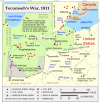
Tecumseh's War - 1811
Many Indian tribes roamed this part of the Wabash Valley before the thriving trading post of Keth-tip-pe-can-nunk was established in the eighteenth century. Known to many as "Tippecanoe", the village thrived until 1791, when it was razed in an attempt to scatter the Indians and open the land to the new white settlers.
Seventeen years later a new Indian village was established on or near the old Keth-tip-pe-can-nunk site at the Wabash/Tippecanoe River junction. Known as "Prophet's Town", this village was destined to become the capitol of a great Indian confederacy -- their equivalent to Washington, D.C.
The town was founded in May, 1808, when two Shawnee brothers, Tecumseh and Tenskwatawa (the Prophet), left their native Ohio after being permitted to settle on these Potawatomi and Kickapoo-held lands.
Tecumseh and the Prophet planned to unite many tribes into an organized defense against the growing number of western settlers. Through this union they could defend the lands they had lived on for thousands of years.
The white settlers of the Indiana territory were disturbed by the increasing activities and power of Tecumseh's followers. In the late summer of 1811, the governor of the territory, Gen. William Henry Harrison, organized a small army of 1,000 men, hoping to destroy the town while Tecumseh was on a southern recruitment drive. The regiment arrived on Nov. 6, 1811, and upon meeting with representatives of the Prophet, it was mutually agreed that there would be no hostilities until a meeting could be held on the following day. Harrison's scouts then guided the troops to a suitable campsite on a wooded hill about a mile west of Prophet's Town.
Upon arriving at the site, Harrison warned his men of the possible treachery of the Prophet. The troops were placed in a quadrangular formation; each man was to sleep fully clothed. Fires were lit to combat the cold, rainy night, and a large detail was assigned to sentinel the outposts.
Although Tecumseh had warned his brother not to attack the white men until the confederation was strong and completely unified, the incensed Prophet lashed his men with fiery oratory. Claiming the white man's bullets could not harm them, the Prophet led his men near the army campsite. From a high rock ledge west of the camp, he gave an order to attack just before daybreak on the following day. 17
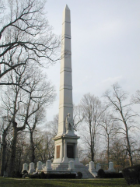
Monument at Battle of Tippecanoe
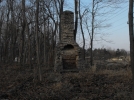
Wilson family home site along Horney Creek, Logansport, IN
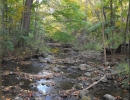
Horney Creek, Logansport, IN
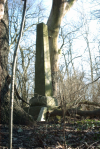
General Walter William's grave marker, family cemetery, North side of Wabash River, Logansport, IN
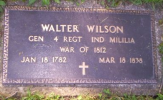
1805
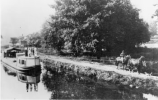

The 'Old Peru Golf Course Club House' formerly the Wilson's 1840 home on Strawtown Pike, Peru IN.
1.3.1.2 George W. Wilson, b. Aug. 16, 1832 d. ; m. Nov. 10, 1857, Mary Rettig, (daughter of George and Anna M. (Snyder) Rettig, b. Columbus, Ohio, January 22, 1833.
1.3.1.2.1 Alexander R. Wilson
1.3.1.2.2 Frank Wilson
1.3.1.2.3 Lewis Wilson
mining accident, no wife no children. 13
1.3.1.2.5 Mary L. Wilson
1.3.1.2.6 Elizabeth Wilson
1.3.1.3 Indiana Wilson, b. Aug. 8, 1836, ; m. John T. Stevens (first white girl born in Peru)
1.3.1.4 Louisiana Wilson, b. ; m. John T. Parmelee of Indianapolis
1.3.1.5 Walter G. Wilson, b. September 30, 1838 Peru, IN. d. August 23, 1897; m. June 20, 1866 Anna Eliza Scott, (Miami County IN.) b. Apr. 6, 1845 Peru, IN. d. Aug. 22, 1898.
Civil War Veteran - enlisted June 24, 1861 Peoria County Illinois as a private in Company E, 17th Regiment Illinois Infantry, Union, mustered out June 24,1864 as Sergeant. Buried Oak Grove Cemetery in Peru Indiana, (to the north and west of Mount Hope, later merged with Mount Hope, Peru Twp.) Section A, Lot 28, Space 3 & 4.
Alexander Wilson was the eldest son of General Walter Wilson. He was born at Vincennes in Jan of 1805. He moved to Logansport in 1827. On 28th of May 1829 he married Matilda Thorp. She was the daughter of Moses Thorp. After Alexander and Matilda were married they went to housekeeping there and kept one of the first public house or tavern. ".. a two-story frame, on the northwest corner of Market and Walnut streets, was built by Alexander Wilson and Moses Thorpe, his father-in-law. This house was known as the " Wilson & Thorpe Hotel." 26
They moved to Peru in Oct. of 1834. (Per newspaper accnt, Matilda had one of the first white wedding in Cass Co., Indiana. Mr. Wilson build a two-story frame house on the North East corner of 2nd and Miami streets. Which they occupied as a dry goods store and swelling. The building was called Wilson's Row.
In 1840 he secured land in Washington twp. where he built a brick house on Strawtown Pike about a mile south of Peru. The property now belongs to the Municipal Golf Course. The land secured by Alexander Wilson is part of the Maconaquah Park on which the golf course is situated. The home was considered a mansion, and was considered a gathering place for politicians and a social center. The home was built a few years before Alexander enlisted in the Mexican war.
In 1839 he shipped pork on the canal to NY, but it was a financial failure because of the low water in the Maumee River. He was engaged in the general store business and meat packing business. He was located at the northeast corner of Miami Streets and Second Street. In 1839, he merged with John Graham. The company was call A. Wilson and Co. They packed pork.
In 1840 he built flat boats and shipped pork to New Orleans, Mr. Wilson often went with the boats and sometimes took his family with him. At nights the boats were tied up to the bank and Alexander would entertain all aboard by playing the fiddle.
He was a public spirited man, served as commissioner of Miami Co. he was on the commission when the covered bridge was built at the foot of Brodway in 1844. In 1839 and 1840 he represented Miami Co. in the State Legislature, he traveled on horseback or stage. 13
Per L.S. newspaper: Alexander was an Indian trader; also a contractor; voted in the first Cass Co. election November 1829; on the first traverse jury. He and Thos. Scott constructed sections 147 & 153 of the Wabash Valley & Lake Erie Canal 1838. Partner with father -in-law Moses Thorp in a hotel at NW Walnut & Market Sts; Wilson & Thorpe Tavern was a two story frame.
He was a sutler, (a person that follows the Army troops and sells them goods.) in the Mexican war, having gone out in 1846, and was killed three days after peace was declared. Wilson was killed on August 11. 1848 by Mexican guerillas a few miles from the Mexican border.
From the Biographical and Genealogical History of Cass County:
Miami County was formed from Cass County in 1834. The county seat, Peru, was originally called "Miamisport." The town of Miamisport was laid out in 1828. Some early county records were destroyed by a courthouse fire in 1843.
Photo of brick home on Strawtown Pike Alexander built in 1845 on file with CAB's records. Per Miami Co. Historical Society, History bulletin, "Many elite social functions took place here."
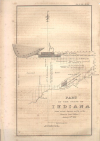
Partial map of Indiana - 1831

Map detail
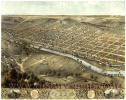
Peru, Indiana - 1868
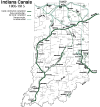
Indiana Canal Map
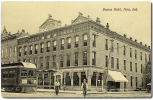
Bearss Hotel,
Peru Indiana - 1909

The 7 Pillers near Peru on the Mississinewa River
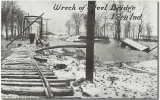
Wreck at Steel Bridge - 1913

Peru In. Flood - 1913
